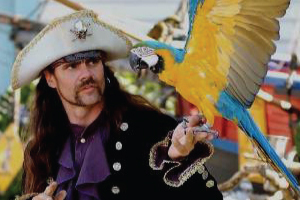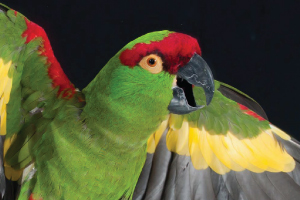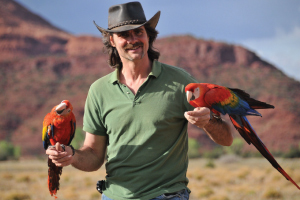
A Little Motivation Is A Good Thing
Chris Biro wrote: “Motivation is the kind of thing that a little is enough, and more is not always a good thing.”
A List Member wrote: “Could you give a couple of actual examples? Here is what happened this morning with Mirt. I placed her on the perch outside the aviary. I went back 3 feet and called “fly to me”, she came and I gave her sunflower seeds and took her inside. Later the same day she was perched in the aviary. I asked her ‘Fly to me’ she flew away. I asked again. She flew further away. I stopped asking.”
I have said many times on the list that there are other factors to training besides just food for motivation. Food management is only ONE way to generate motivation. If you rely solely on food management or weight control, then you are not developing any of the other forms of generating motivation. This means that if you rely so heavily on food and/or hunger then you will always need food and a healthy appetite to get the behavior to happen reliably. Mastering some of the other training skills will help you develop motivation from various sources that will help you get behavior reliably even without constant food being present. There are many little “tricks” that people use to help get behavior to be both learned and performed (criteria and motivation). If your training skills are well developed than you are using many of these little tricks and using food less and less. This is not to say that food is not a primary tool. It is by far the most simple way to motivate an animal and is the easiest form of reinforcement to control access to and delivery of to the animal. So don’t get me wrong here, food is an important tool. But it is not the ONLY tool.
Your post above demonstrates this a little. Good training skills should show themselves through good training habits. Setting the animal up to succeed is a good training habit. Asking a bird to fly to you when the antecedents suggest that it will not comply, is not a good training habit.
Behavior is not really a single incident or repetition as is often implied by the ABA model. Even though behavior can be broken down into its most basic elements of Antecedents, Behavior, Consequence (ABC’s), the consequence of one behavior is also the antecedent for the next behavior. Behavior is more like a movie reel of film where each repetition is a single frame of film. As the reel rolls, the frames are replaced by the next frame, but at a pace that lets it appear as if everything is in motion. Each frame though has links to past frames. In a movie we might think of those links as similarities in the theme or similar objects in view. But with behavior the links are antecedents, where SOME of the antecedents are past consequences. Having a heavy focus on food or hunger as the main form of generating motivation is focusing on Consequences while ignoring the OTHER important antecedents. These antecedents are EVERYTHING! If you are good at controlling the antecedents, then only mild focus is needed on the consequence side of the equation. As or more important than what the actual consequence was will be issues like timing of delivery of consequence, frequency of repetitions, environmental distractions or cues (also antecedents), timing of the cue, etc. The consequence is what happens AFTER the behavior happens. I point this out here because if you are focusing on hunger as your main tool to get a behavior, then you are focusing on an aspect that the animal wants that is in no way associated with the behavior until AFTER the behavior happens. On the other hand if you are focusing on the other antecedents – hunger or desire for favorite treat is only one of the antecedents – then you are working on additional issues that help CAUSE or trigger the behavior to happen. A good trainer understands how to use any available antecedent to help cause the behavior to happen and then is mindful to make sure that the behavior is reinforced. So once the behavior does happen and the food item is offered, the animal has an opportunity to learn there is an association between the desired item and the behavior performed. But if the animal is too heavily focused on the desired item, then it is not as likely to understand the association. There is a point where too much desire for the item is no longer helpful but rather is distracting and thus unhelpful. If all the trainer is focused on is food or weight as the main method of generating motivation, then the likely result of poor performance by the animal will be attempts by the trainer to increase the animal’s desire for the food. But this may make things worse rather than better – this is at the extreme end of the scale and an animal would need to be severely hungry to be that distracted. But maybe more importantly, the trainer is not learning to use the other antecedents that are available.
Motivation is simply the animal’s willingness to take an action. Desire for food is one way to get an animal to desire to take an action. Note that it should be understood that WHICH action the animal takes is not really determined by a desire for food. What determines which action will be taken is the consequence of the animal’s past behavior, or more accurately, how the animal remembers that past behavior. Of course we cannot tell what the animal’s memories are so we can only rely on what WE know of the animal’s past behavior. Of course we are doing our best to control those behaviors and their consequences so that we have a better idea of what the animal remembers about the past behaviors. As such, this history becomes an important part of the antecedents for the next repetition. Obviously hunger or desire for an item (hunger and desire are not always the same thing) are only PART of what the animal will remember about the past behaviors. Actually I don’t think they really remember the hunger part so much. I think their memory will be mostly of the item itself or the elements that made the item accessible. I have no way of knowing this for sure but my own experience tells me that I don’t remember my own hunger as much as I remember how good the food was and how I came to eat it. In any event, this history is made up of many details, not just the food. As the trainer it is my job to make sure that I can arrange things so that as many of these details as possible all point toward the animal choosing to do the target behavior.
As a general rule, improvement to the basic behavior need to be brought about via criteria adjustments, not through attempts at increased motivation. Increased motivation can be useful once the criteria are fully understood and refined and where the focus has shifted to personal effort of performance. Who will run the fastest to the end of the track is about motivation. The task is well defined and fully understood. Criteria are no longer really an issue. Technique of running style is a criteria issue but level of effort put forth is motivation. For the most part, the behaviors that we are training our birds to do are NOT dependent on personal effort.
We at this time do not have competitive sports for parrots as exist in the dog world. Flyball is such a sport for dogs. The criteria are pretty simple. The dogs learn to run down a track, jump over some small jumps, retrieve a ball from a special box, turn around and run back to the start line, also jumping over the same small jumps. For some trainers, some highly specialized training goes into teaching the dog the criteria for how the trainer wants the dogs to make the turn on the box, increasing speed of the turn and safety for the dogs body. But much of the rest of this behavior is about motivation, getting the dog to put everything it has into running as fast as it can. I am not aware of any of us actually working on any behaviors with our birds that have reached that point of training for personal effort. Hawk evasion skills could be such a behavior but none of us at this time are engaged in actually training increased evasion skills. We rely on the bird’s own abilities for this. Maybe someday we will have events that focus on competitions where many of those same skills are used in competitive events. But today, nearly all of our training is criteria based, not personal effort based. As such, a little motivation is enough. The rest is criteria.
It has been suggested that it is better to keep the animal more hungry to get the animal to be more willing to take action. This is often incorrectly referred to as increasing motivation. There is a huge difference between motivating an animal to be willing to “do a simple behavior” and motivation needed to get “top personal performance”. Motivating an animal to be willing to take an action is simple and once the level of motivation is achieved, any “additional motivation” is likely to be frustrating and counter productive. Personal performance involves effort. Putting forth high levels of effort can be an aversive condition. This is why we normally do NOT always put forth our strongest effort except in special cases. I believe it is best to keep the animal’s level of personal effort as low as is needed for getting the desired behavior. Asking for high level of motivation just to get willingness to do a simple behavior is asking for high level of effort where low level of effort is all that is needed.
The point I am trying to make here is that it only takes a certain amount of motivation to get a willingness to do the kinds of behavior we are generally after. Any additional ramping up is unnecessary and potentially distracting.
At the start of training a new behavior, it might take more effort on my part to arrange things so that the bird will take action. But as repetitions continue, it should take less and less effort to get the desired behavior – and the antecedents should become fewer also. As the behavior becomes well trained, it should also take less and less reliance on hunger or desire for the treat. As the animal truly learns good stimulus control, performance should approach virtually zero motivation – not referring to performance based behaviors as discussed above. It should take little to nothing offered to get the desired behavior. The cue itself becomes sufficiently reinforcing to sustain the behavior. That of course is an ideal standard that is difficult to reach and will vary based on the nature of the specific behavior – natural behaviors will be the more likely to achieve this level and unnatural behaviors will probably never reach this level. But reaching that level is what I consider performance due to habit.
Parrots: More Than Pets, Friends For LifeChris Biro
Resources and More
The Pirate's Parrot Show
An educationally based pirate-themed parrot show performing at state and county fairs since 1991. The Pirate’s Parrot Show is a Fun, Educational, and Interactive experience for all ages and cultures.
Bird Recovery International
One in every eight bird species in the world today is in danger of extinction and these numbers are increasing! Find out how this non-profit organization started by Chris Biro can help save and protect parrots and other birds.
Podcasts with Chris Biro
An Alternate Perspective – Enjoy these audio Podcasts of Chris with guests discussing the nature of training flighted birds. The discussions are intended to be loosely structured around a general topic.
Email Us
chris@libertywings.com
Call Us
(206) 618-2610
Contact Us
By Using the Contact Form




I went arround the the internet and get there by a chance. I am from jakarta, Indonesia where free flighted bird is a very rare hobby.
For what you have explained, I only understand the concepts but still guessing the actual examples. I have the same objective to fly the parrot outside and have the same reluctancy from the pet bird. Need you to elaborate the examples if you don’t mind.
Rgds,